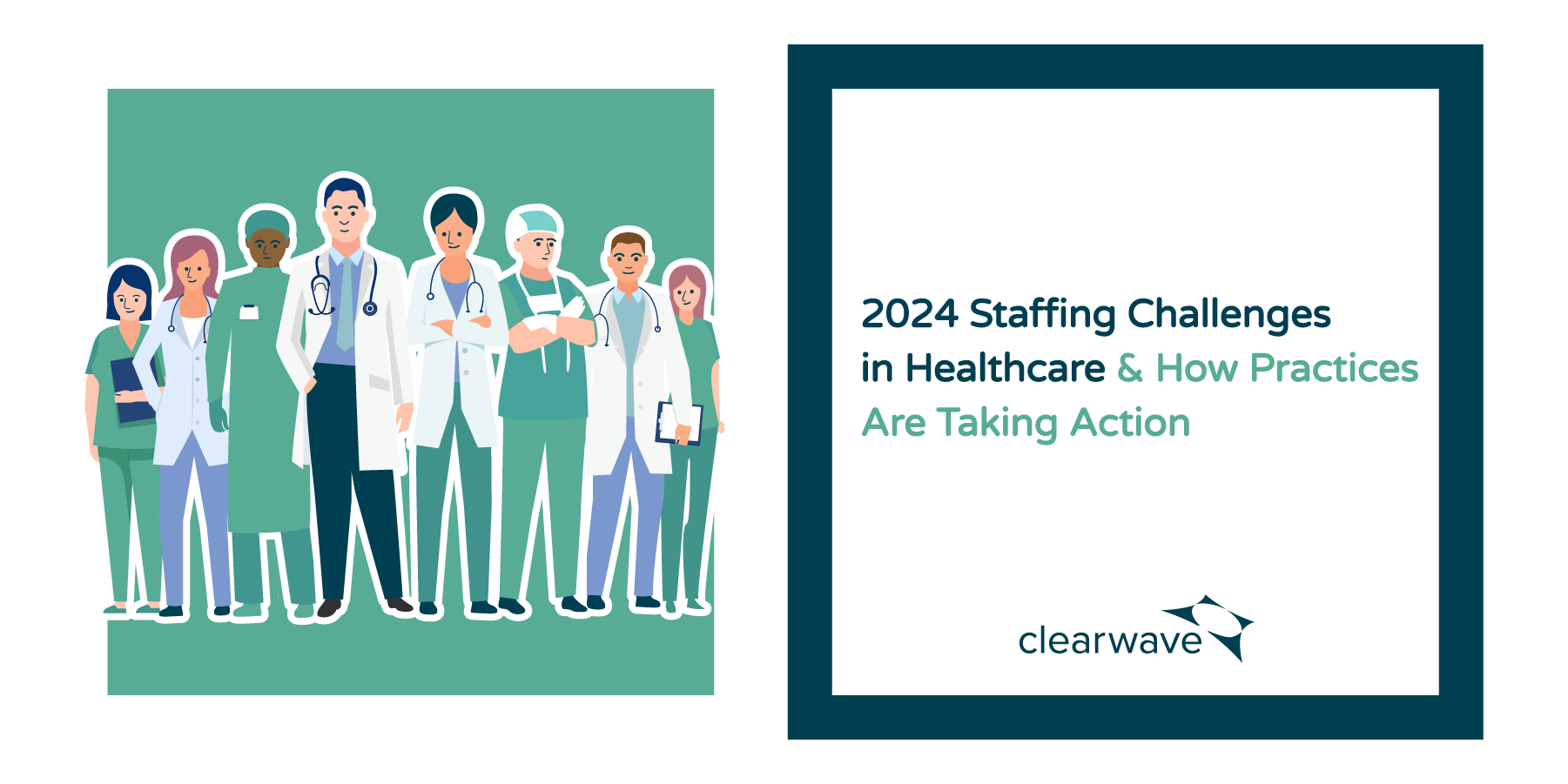2024 Staffing Challenges in Healthcare & How to Take Action

By Chloe From Clearwave | January 8, 2024
A crisis point looms in American healthcare. According to recent projections, the United States could see an estimated shortage of between 54,100 and 139,000 physicians, including shortfalls in both primary and specialty care, in the coming years. This staffing challenge extends beyond the clinic and into administrative roles. To circumvent shortages, states across the nation are rising minimum wages for all roles, from physicians to the front desk, in hopes of increasing employee interest in the field and boosting retention.
Nationally, the American Medical Group Association reports staffing costs are up 10% and growing. Adding to the increase, 56% of medical practices report they are increasing benefits packages to stay competitive in the market for competent employees.
Practices are looking for ways to simply keep up, yet between staffing shortages and increasing costs, they’re facing a bleak reality. Solutions that reduce administrative burdens and unlock workforce productivity, such as intuitive patient revenue platforms, are mission-critical to stretching limited resources.
How to Work Smarter, Not Harder With Proven Automation
No one is immune to rising staffing challenges and costs, but you can take action to mitigate profit setbacks and operational inefficiencies all in one fell swoop! The only answer is automation.
One Becker’s Hospital Review article shares the challenges of recruiting during a workforce shortage and where automation comes into play saying, “Thirty percent of healthcare has the potential for automation, so we really want to reduce administrative burden, reduce manual tasks and processes in order to free up our most valuable asset, which is our people, and make sure they’re doing human-related tasks versus things that could be potentially automated.”
A recent report on the State of Patient Access in 2023 notes that 40% of providers say staff shortages have been offset by technology improvements. Additionally, most healthcare organizations are automating front-end tasks, with 66% using self-check-in kiosks for office visits. As practices confront deepening administrative workforce challenges in healthcare, optimized technology solutions are key to bolstering workforce capacity.
Automated tools can reduce administrative burdens and maximize existing staff productivity. By leveraging automated solutions for patient scheduling, registration, multi-factor eligibility™ verification, communications and collections can support understaffed specialty practices in unlocking productivity gains and increased profits. Such solutions not only streamline front and back-end processes to save time, but allow practices to redirect budget towards other areas of the practice to improve patient care and operational efficiency. With the widening gaps between patient demand and clinician capacity, technology that does more with less has become mission-critical. Let’s dive deeper into how you can automate three essential patient touchpoints.
-
Patient Scheduling
Innovative patient scheduling software is enabling practices and federally qualified health centers (FQHC) to expand access and acquisition even amidst tightening staff resources. Solutions that provide 24/7 self-scheduling options through integrated patient portals make finding care more convenient.
With flexible scheduling workflow logic, you can meet provider requirements for bookings and relieve staff of a majority of patient booking tasks.
Give patients a way to fly through scheduling, regardless of your specialty or if you’re an FQHC, and gain control over how they manage healthcare appointments. In turn, this frees up overloaded teams from manual scheduling tasks, enabling them to focus on higher-value work. Self-scheduling empowers healthcare organizations to efficiently scale, overcoming the capacity challenges of staffing constraints.
To learn tactical tips for overcoming staffing shortages using smart scheduling, check out this blog: 2 Smart Scheduling Tactics to Overcome Staffing Shortages and Improve Patient Access. Implementing proactive scheduling strategies can help expand access despite resource constraints.
-
Patient Registration & Clinical Intake
Self-service digital registration and check-in solutions directly address staffing challenges by reducing the manual tasks involved with patient check-in, like payment collection, data entry, clinical intake and more. Pre-check allows patients to complete forms in advance from home, saving them time filling out paperwork on-site and removing the need for staff to transfer data into their EHR/PMS. Pre-check and self-registration via kiosk, mobile, or tablet allow practices to remove staff from the time-consuming activities around registration.
Staff only need to engage with those patients who truly require assistance, enabling your practice to increase efficiency and allocation of limited human resources. Watch our insightful webinar “How to Increase Patients, Not Payroll” for more details on how leading practices are reducing workloads and driving revenue with digital registration.
-
Appointment Reminders and Recalls
Keeping patients engaged and informed is important to reduce no-show rates and drive revenue amidst the staffing challenges in healthcare. Automated reminder systems are a key strategy for achieving this, allowing practices to reduce cancellations and no-shows, without staff having to call on every patient. Instead, smart patient communication tools can send customizable phone, text or email notifications at optimal cadences to prompt patients about upcoming appointments.
Patients appreciate the convenience of confirming visits or adjusting details simply via embedded links rather than calls. The self-service functionality not only saves staff hours, but also helps keep schedules full. Additionally, custom patient recall messages can be triggered to target patients and notify them that it’s time to book their next appointment with your practice. By automating patient recalls you can further reduce staff workloads around patient communication, while still reducing lapsed patients and increasing revenue potential.
With physician capacity already stretched thin, keeping existing patients engaged through strategic reminders and recall messaging is crucial. Automated tools that reduce appointment churn while improving retention simultaneously promote practice growth and care continuity. Even when hiring additional providers proves difficult, optimized patient communication sustains operations.
Can You Afford Not to Automate Key Patient Touchpoints?
As practices seek solutions to pressing staffing challenges in healthcare, leveraging supportive technologies is mission-critical for sustainability.
Clearwave’s Patient Revenue Platform helps practices do more with less. Grab a demo to see how you can use Clearwave to automate key patient touchpoints and reduce staff workloads, rehiring and FTE funds altogether!
Recommended for you
Related Posts
Long-Lines Giving You Blurry Vision?
Reading Time: 4 minutes Clearwave & Thomas Eye Group’s 10-Year Partnership Puts Patients First By Blakely Roth | June 18, 2024 In an era…
3 Ways to Gastroenterology Practices Use Patient Check-in Software to Augment Staff Workloads
Reading Time: 4 minutes By Chloe From Clearwave | June 13, 2014 The healthcare industry is battling a multi-faceted workforce crisis, and no specialty…
5 Ways Family Medicine & Primary Care Practices Can Increase Patient Acquisition
Reading Time: 6 minutes By Chloe From Clearwave | June 3, 2024 Family medicine and primary care practices serve as the front line of…




